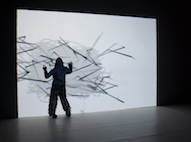The initial research took place in Culture Yard Elsinore at the Click festival 2013. In JAnuary 2014 the project was developed further during a residency at 3LD Art and Technology Center in NYC.
In may 2014 the Click Festival hosted recoil performance group to create an installation based on the STEREO concept.
Stereo – pilot project
A pilot project in 2D

Stereography & spectral comb filtering.
To enact a depth that is not there each human eye needs to receive a separate visual signal. Normally this is achieved by the slight rotation in the geometries of objects as they appear in front of our eyes, separated by a distance spanning the nose. If the geometry is projected and not physically present, some mechanism of sending a distinct projection to each eye is needed. The enacted object can then be depicted from two slightly different angles, each projection reaching one eye and not the other.
For stage use it is desirable to overlay projections of forms on physical forms. This means that the separation of two slightly different light projections must be intact when reflected by the physical form.The only appropriate technique that can achieve full color fidelity while retaining separation of left and right channel is known as spectral comb filtering. It works by separating the emitted light into two sets of tri-stimulant primaries, one inverse to the other. The red green and blue channels of one projector are filtered in half, one set of primaries for each eye. On stage the projections merge in a double image where the colours of one image appears to be warmer and the other colder. A set of glasses with the same spectral comb filters as the ones used in front of the projectors makes sure to seperate the reflected double image on stage into two seperate images, one for each eye.
Presence of the dancer
Breaking down how stereography – and therby sterographic scenography – succeeds in creating the “make believe” of depth, reveals an intriguing sensory play with both perception and presence of space, performer and observer. Depending on how the interaction between dancer and video-scape are used, the relation between these two elements might question the inherited hierarchies of the performative space–from the secure dancing soloist being the absolute center focus around which the “world” revolves, to a shared space where all elements have a voice. Contemporary dance has dealt with this subjectivity of the performer for decades. The displaced, deformed or absent body is an applied aesthetics in works by choreographers going back to the 80’s. However, by pursuing the the intention of dissolving hierarchies we might find the dancer in new roles as she enters a dialog with the sterographic space. Specific core subjects in the stereoscopic environment is duality and illusion. Addressing these subjects through performative actions and structural rearrangements of the space, is our desired direction for applying a dancers presence into this space.
Software artist: Johan Bichel Lindegaard
Software artist: Ole Kristensen
Software artist: Bernado Schorr
Software artist: Maria Paula Saba
Dancer: Siri Wolthoorn
Dancer: Andrea Lund
Choreographer: Tina Tarpgaard

In 2013-2015 Recoil Performance Group will explore the scenographic potentials of stereographic projections. With access to spectral comb filters and glasses it will be possible to develop our existing minimalist scenery of dynamic trompe l’oeil projections with live manipulations of the perceived distance and scale of the stage space.

